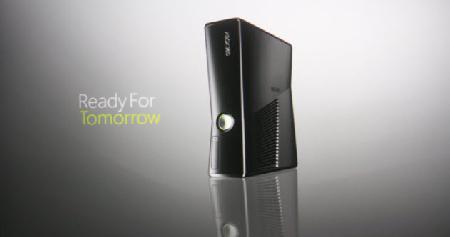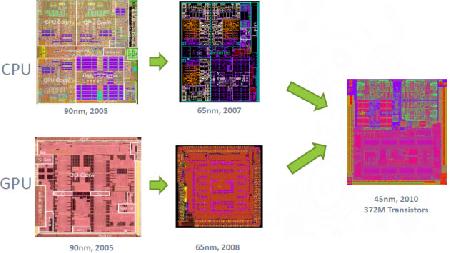
Lifting the veil on the hybrid processor-graphics chip in the new Xbox 360 S
Date: Friday, August 20 @ 00:20:56 UTC
Topic: Xbox 360
Microsoft and IBM described the two-headed chip that enables the new black version of the Xbox 360 to operate on less power and more quietly than past models of the video game console.
The companyís engineers created a chip that combined the machineís microprocessor and its graphics chip on a single piece of silicon. In the past, different versions of the console have all used two separate chips for those tasks. By combining them, Microsoft and IBM were able to make substantial reductions in space, cost and power for the final machine, allowing Microsoft to add new features such as wireless networking at the same time.

The code name for the project was Vejle, named after a city in Denmark. (Itís not Valhalla, as some thought). Rune Jensen (pictured left), chip design lead at Microsoft, declined to say how long it took to create the hybrid chip, but Microsoft has been rolling out new versions of the Xbox 360 every couple of years since the launch of the original Xbox 360 in 2005. The chip design process gives a rare window into the difficult choices and design process that goes into managing the life cycle of a video game console.
Redesigning a game console is important even though the redesigns to not make the game consoles faster. The console performance has to stay the same in general because it allows game developers to target a stable platform. But itís important to reduce the costs, power, and size of the consoles because the rival console makers are in a constant battle to lower their prices and make their machines more appealing to gamers. On the PlayStation 2, introduced in 2000, Sony was able to redesign the chips inside it constantly until, a couple of years ago, it had combined the two main chips inside it into a single chip and reduced the overall size of the chips to 13 percent of the original chips in the system.

The combined chip has 372 million transistors, the basic on-off components of electronics. IBM and another unnamed manufacturer are building the chip in a 45-nanometer silicon-on-insulator manufacturing process. (The original partner was Chartered Semiconductor, which was purchased by Globalfoundries; itís logical to assume Globalfoundries is the other partner, which allows Microsoft to benefit from a second-source strategy in terms of pricing for chips).The manufacturing process is particularly important in reducing costs and power. It allows a chip maker to create a chip with smaller circuitry, which in turn leads to smaller size, power consumption and costs. But new processes come along every couple of years, since it takes billions of dollars to make the factories that use the new processes.
The original microprocessor (designed by IBM) and the original graphics chip (designed by Advanced Micro Devicesí ATI Technologies graphics chip division) were built using a 90-nanometer silicon-on-insulator manufacturing process. The graphics chip in particular ran so hot that it could warp the system board and result in unexpected console failures, which were dubbed the Red Ring of Death. So many systems failed that Microsoft had to set aside $1.05 billion to $1.15 billion for the cost of replacing defective consoles.
IBM created a smaller version of the microprocessor in a 65-nanometer process in 2007, and then Microsoft managed the redesign of the graphics chip in a 65-nanometer version launched in 2008. That redesign helped reduce the system failures dramatically. The aim of the hybrid microprocess0r-graphics chip was to reduce system costs and power consumption further than had already been done, Jensen said.
 The new chip takes the exact same 3.2-gigahertz, three-core microprocessor and 500-megahertz graphics chip design and puts them on the same chip. In order to create this, Microsoft and IBM engineers had to work together to build the necessary connectivity within the chip to route electrical signals in and out of the chip. You canít just glue the two designs together. Rather, IBM had to get rid of its main communications channel between the chips, dubbed the front-side bus, and build a substitute for it. The new chip takes the exact same 3.2-gigahertz, three-core microprocessor and 500-megahertz graphics chip design and puts them on the same chip. In order to create this, Microsoft and IBM engineers had to work together to build the necessary connectivity within the chip to route electrical signals in and out of the chip. You canít just glue the two designs together. Rather, IBM had to get rid of its main communications channel between the chips, dubbed the front-side bus, and build a substitute for it.
The main chip is packaged with a separate 10-megabyte embedded memory chip (pictured, right). So the two chips are packaged in a single module. The combined chip uses 60 percent less power than the original 2005 pair of chips, and it uses 50 percent less space. Robert Drehmel (pictured above, right), senior technical engineer at IBM, said that one of the big challenges was to marry two chips that were built by different companies, designed by different engineering teams, and created with different chip design tools. IBM had to learn more about the unfamiliar ATI design, design specific tools to adapt it, and then recreate an overall design that did the same thing as the prior designs.
To test the designís quality, IBM had to apply a technology it called sequential equivalence. That means it had to test its own design against the prior designs and make sure the given output from an electrical process was exactly the same. That way, it could ensure that games designed for the older consoles would play perfectly on the new console. Drehmel said it wasnít a trivial matter to redesign the chips without breaking compatibility.
 Drehmel said that the engineers were able to use more automation in the redesign of the chips over time. That helped reduce engineering costs and keep the design on schedule. Jensen said the company met its goals on cycle time. (In general, Microsoft has been introducing new chips every couple of years). Nintendo has been cutting costs from its Wii console, introduced in 2006, but has been much less public about it. Sony has also been redesigning its PlayStation 3. Last year, it introduced a significantly smaller PS 3 console that was cheaper and smaller. That allowed Sony to get back in the game. Drehmel said that the engineers were able to use more automation in the redesign of the chips over time. That helped reduce engineering costs and keep the design on schedule. Jensen said the company met its goals on cycle time. (In general, Microsoft has been introducing new chips every couple of years). Nintendo has been cutting costs from its Wii console, introduced in 2006, but has been much less public about it. Sony has also been redesigning its PlayStation 3. Last year, it introduced a significantly smaller PS 3 console that was cheaper and smaller. That allowed Sony to get back in the game.
The results of the Microsoft redesign have been good. Microsoft has used Vejle to create a sleeker and smaller black version of the Xbox 360. Since it was introduced in June, the new Xbox 360 has been the best-selling console in the U.S. The new chip uses 60 percent less power than the previous chips, resulting in a much smaller power supply. The system can also get by with a single, much quieter system fan. The new console is whisper quiet, and even in hot environments the fan doesnít really have to go above 55 percent of its capability.
Microsoft isnít commenting on what is coming next. But clearly the work of making a console cheaper, smaller, and less power hungry is never done. And as you can tell from this talk, thereís an awful lot of work that goes under the hood in a game console.
News-Source: venturebeat.com
|
|